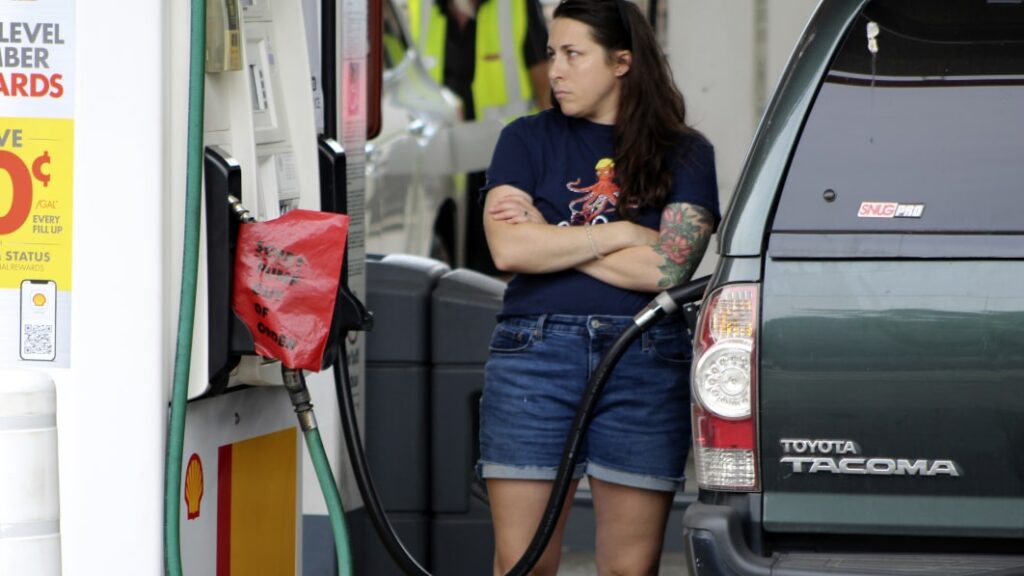Gas prices are higher again, hitting consumers 'very directly and very profoundly'

Gas prices are just plain high, and consumers are taking notice.
As of Wednesday, the national average gas price stands at $3.83 per gallon, per AAA. That’s lower than the average price this time last year, at $4.06, but higher than last week’s average price at $3.78.
And that may have larger implications on consumer spending and how Americans feel about the economy, especially heading into the important back-to-school shopping season.
“[Consumer] sentiment is very directly and very profoundly affected by gas prices,” Michael Zdinak, economist at S&P Global Market Intelligence, told Yahoo Finance (see chart below). He added that there’s a roughly 70% correlation between gas prices and sentiment over the time period shown below.
One reason for that is consumers see gas prices and food prices move in real-time, he said.
According to eToro global market strategist Ben Laidler, the move in gas prices from $3.09 in December 2022 to the national average price on Monday at $3.83 is an extra annual cost of roughly $101 billion for US consumers in total (based on the estimate that Americans use roughly 375 million gallons of gas each day).
With where gas prices stand — and they should remain elevated — that means consumers have less money to spend elsewhere, such as discretionary purchases.
‘Sour outlook’ for retailers?
Higher gas prices, in addition to a slowdown in the U.S. job market, the looming return of student loan payments this fall, higher mortgage rates, higher interest rates, higher cost of groceries, and a potential rise in the CPI reading due out this Thursday could form a perfect storm for U.S. consumers — and change the way they shop.
If American consumers’ fears about the economy start to happen, incomes will take a hit, Zdinak said, which in turn could “sour our outlook for spending.”
Yet “consumers have been shockingly resilient” following a pandemic, ongoing war overseas, and a bank crisis earlier this year, he added — so it will take a lot to change the narrative this year.
Some of these themes are playing out in the back-to-school shopping season already underway.
A Deloitte survey found that 68% of U.S. parents expect to spend the same or less on back-to-school compared to last year. More than half (51%) said inflation is to blame for less disposable income while 75% said they plan to spend less because of higher prices.
Although spending habits for the back-to-school season won’t be reflected in next week’s quarterly retail earnings results, Morningstar senior analyst David Swartz noted that “expectations are not high, partly because of the gas prices and student loan payments but mostly because spending on apparel has cooled off since a very strong year in 2021.”
“Retailers that cater to wealthier shoppers, such as Lululemon or Anthropologie, may be doing better than ones that sell to lower-income consumers, like Kohl’s or Urban Outfitters,” said Swartz, who covers retailers such as Macy’s (M), Nike (NKE), and Gap (GPS).
Excess savings to be depleted by the end of the year, per BNP Paribas
There’s another factor that could affect consumers’ ability to ride out higher gas prices: diminishing savings.
“All this savings accumulated from the pandemic,” BNP Paribas senior US economist Andy Schneider told Yahoo Finance. “That was a real tailwind last year while the real wage story was a headwind, so … now they’ve really flipped.”
According to Schneider, those excess savings allowed consumers to “shrug off” headwinds such as higher inflation and high gas prices.
But now, “excess savings is becoming more of a headwind,” he added. “It’s running down and we think that should be more or less depleted by the end of the year.”
All this means less extra cash for consumers to sit on.
“I think it’s just a new era,” Schneider said, adding: “Now people are going to have to broach something like higher gas prices without being able to rely on a higher stock of savings that they had last year, and this year they don’t.”
Still, there may be some good news for Americans: Outside of a major shock to oil prices, the worst may be behind us when it comes to higher prices at the pump.
“Barring a hurricane or OPEC production cut, we may have seen our peak and may see slight declines (not major),” Patrick De Haan, GasBuddy head of petroleum analysis, told Yahoo Finance. “But with a lot impacting the market from economic data, etc, we’re one surprise away from seeing gas prices going right back up.”
—
Brooke DiPalma is a reporter for Yahoo Finance. Follow her on Twitter at @BrookeDiPalma or email her at bdipalma@yahoofinance.com.
Click here for the latest economic news and economic indicators to help you in your investing decisions
Read the latest financial and business news from Yahoo Finance



